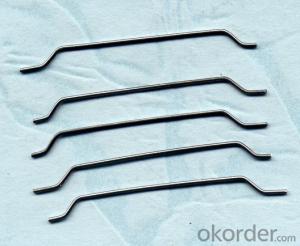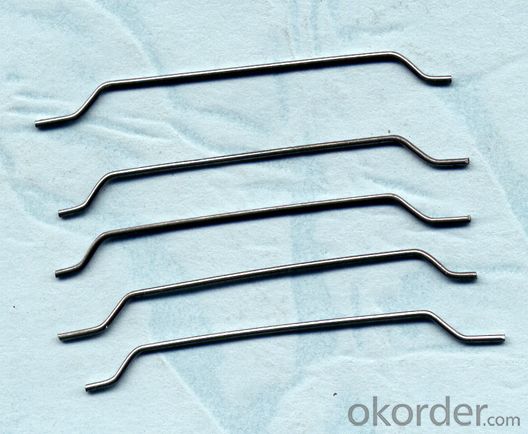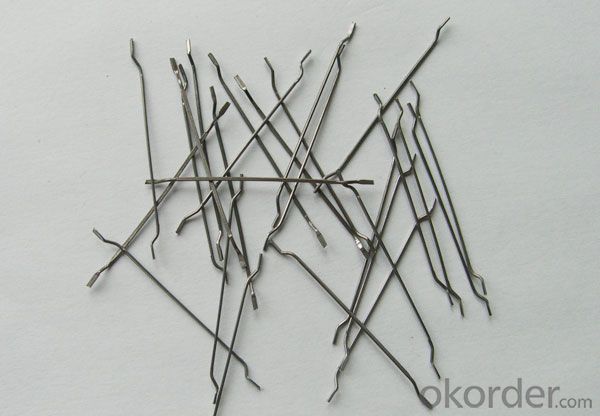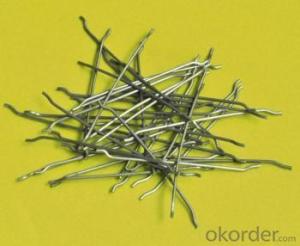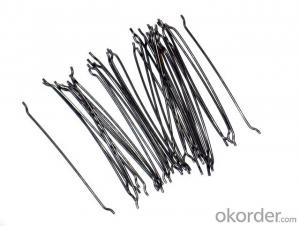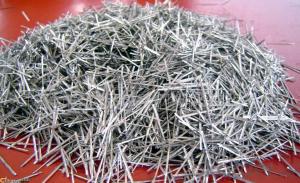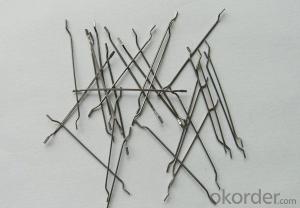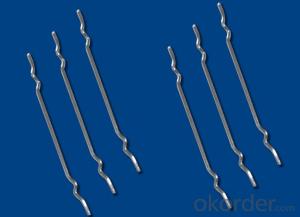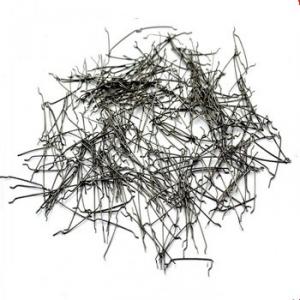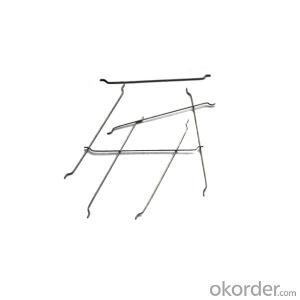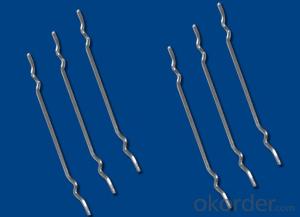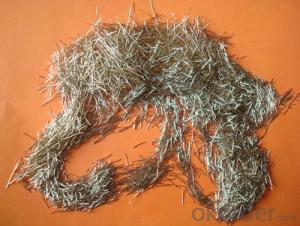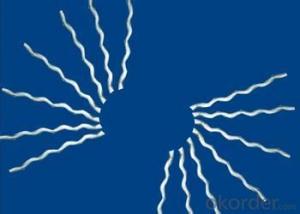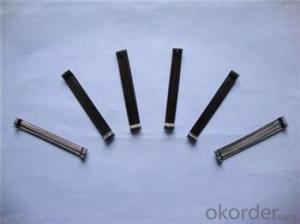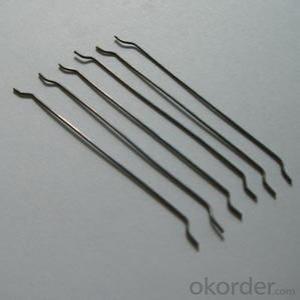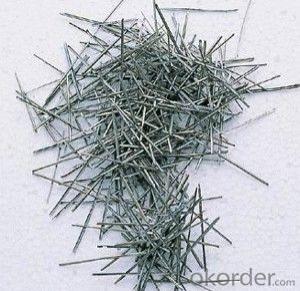Melt Extract Stainless Steel Fiber for Concrete Reinforcement Glued in a Row
- Loading Port:
- Tianjin
- Payment Terms:
- TT OR LC
- Min Order Qty:
- 5 m.t.
- Supply Capability:
- 30000 m.t./month
OKorder Service Pledge
OKorder Financial Service
You Might Also Like
Quick Details
Place of Origin: Hebei, China (Mainland)
Model Number: CW04
Material: Steel
Material:: Steel,low carbon steel wire
Standard:: ASTM ,ISO9001,CE
Shape:: hooked ends and straight middle
Grade:: Q195
Application:: shortcrete on tunnel, underground project, dam plate
Tensile strength:: 1100MPA to 2850Mpa
Demension:: per your requirement
Delivery Detail:: in 7 days upon receive prepayment
The products
Steel fiber for Concrete Reinforcement
1.High tensile strength
2.Length 6-60mm
3.Diameter 0.2-1.0mm
4.ISO9001, CE, TUV
Specifications
Specification | Diameter (mm) | Length (mm) | Aspect ratio (L/D) | Tensile strength (Mpa) |
0.12/6 | 0.12 | 6 | 50 | 2500 |
0.2/6 | 0.2 | 6 | 30 | 2500 |
0.2/13 | 0.2 | 13 | 65 | 2500 |
0.3/25 | 0.3 | 25 | 83 | 2500 |
0.4/25 | 0.4 | 25 | 63 | 1200 |
0.4/30 | 0.4 | 30 | 75 | 1200 |
0.5/30 | 0.5 | 30 | 60 | 1100 |
0.5/25 | 0.5 | 25 | 50 | 1100 |
0.55/25 | 0.55 | 25 | 45 | 800 or 1000 |
0.6/30 | 0.6 | 30 | 50 | 1000 or 1100 |
0.7/30 | 0.7 | 30 | 43 | 1000 |
0.7/35 | 0.7 | 35 | 50 | 1000 |
0.75/35 | 0.75 | 35 | 47 | 1000 |
0.75/60 | 0.75 | 60 | 80 | 1000 |
0.8/60 | 0.8 | 60 | 75 | 1000 |
0.9/50 | 0.9 | 50 | 56 | 1000 |
0.9/60 | 0.9 | 60 | 67 | 1000 |
1.0/50 | 1.0 | 50 | 50 | 1000 |
1.0/60 | 1.0 | 60 | 60 | 1000 |
Picture
PP bag
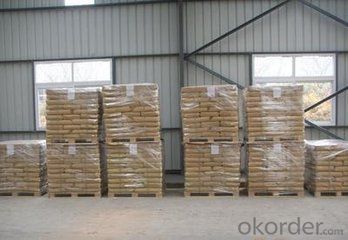
pakage
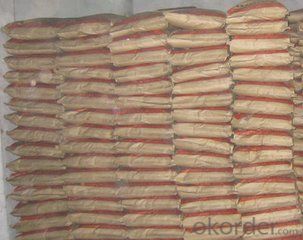
any type steel fiber
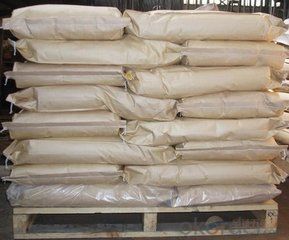
FAQ
steel fiber for concrete reinforcement glued steelfiber in a row>1200Mpa
- Q: How does melt extract stainless steel fiber affect the freeze-thaw resistance of concrete?
- Melt extract stainless steel fibers can significantly enhance the freeze-thaw resistance of concrete. These fibers are added to the concrete mix during the mixing process, and they act as reinforcement within the concrete matrix. During freeze-thaw cycles, water within the concrete expands when it freezes, exerting pressure on the surrounding material. This can lead to cracking and deterioration of the concrete. However, the addition of melt extract stainless steel fibers helps to mitigate this issue. The fibers create a three-dimensional network within the concrete, effectively reinforcing it and improving its resistance to cracking. They enhance the tensile strength and ductility of the concrete, allowing it to better withstand the expansion and contraction caused by freeze-thaw cycles. Moreover, the stainless steel composition of these fibers provides excellent corrosion resistance. This is crucial in freeze-thaw conditions where the presence of water and deicing salts can accelerate corrosion processes. By preventing corrosion, the fibers maintain the structural integrity and durability of the concrete over time. Overall, the incorporation of melt extract stainless steel fibers in concrete improves its freeze-thaw resistance by reducing cracking, enhancing tensile strength, and providing corrosion resistance. This results in a more durable and long-lasting concrete structure that can withstand harsh environmental conditions.
- Q: How does melt extract stainless steel fiber improve the resistance to abrasion in concrete?
- Melt extract stainless steel fiber improves the resistance to abrasion in concrete by providing reinforcement and enhancing the overall durability of the concrete structure. When added to the concrete mix, the stainless steel fibers disperse uniformly throughout the matrix, forming a three-dimensional network. This network acts as a reinforcement, distributing the stress caused by abrasion over a larger area. The stainless steel fibers also help to prevent crack formation and propagation in the concrete. As abrasion occurs, the fibers absorb the energy and transfer it across the concrete, reducing the impact on the surface. This reduces the likelihood of surface degradation and increases the lifespan of the concrete structure. Furthermore, the high tensile strength of stainless steel fibers improves the overall strength and toughness of the concrete. This makes the concrete more resistant to abrasive forces and prevents the formation of surface defects such as spalling, cracking, or wearing. Overall, the addition of melt extract stainless steel fiber to concrete significantly enhances its resistance to abrasion. By reinforcing the concrete matrix, absorbing energy, and preventing crack propagation, stainless steel fibers improve the durability and lifespan of concrete structures, even in high-traffic areas or environments prone to abrasion.
- Q: What is the effect of melt extract stainless steel fiber on the crack width in concrete?
- The use of melt extract stainless steel fibers in concrete has a significant effect on the crack width. These fibers are added to the concrete mixture to enhance its durability and strength. When the concrete is subjected to external forces or temperature fluctuations, cracks may occur. However, the presence of stainless steel fibers helps to control and minimize the width of these cracks. The main reason behind this effect is the unique properties of stainless steel fibers. These fibers are known for their high tensile strength and ductility. When cracks start to form in the concrete, the stainless steel fibers act as reinforcement and distribute the stress across the matrix. This redistribution of stress helps to prevent the cracks from widening. Additionally, the presence of stainless steel fibers also improves the overall toughness of the concrete. As a result, the concrete becomes more resistant to crack propagation. This means that even if cracks do form, they are less likely to extend and cause significant damage. Moreover, melt extract stainless steel fibers also improve the overall durability of the concrete. They act as a barrier against corrosion, protecting the concrete from the harmful effects of moisture, chemicals, and other environmental factors. This enhances the lifespan of the concrete structure and reduces the need for frequent repairs or replacements. In summary, the use of melt extract stainless steel fibers in concrete has a positive effect on the crack width. These fibers reinforce the concrete matrix, distribute stress, and prevent cracks from widening. Furthermore, they improve the overall toughness and durability of the concrete, making it more resistant to crack propagation and extending its lifespan.
- Q: How does melt extract stainless steel fiber improve the resistance to fatigue in shotcrete?
- Melt extract stainless steel fiber improves the resistance to fatigue in shotcrete by increasing the structural integrity and durability of the material. The fibers act as reinforcement, enhancing the tensile strength and preventing crack propagation, ultimately reducing the likelihood of fatigue failure.
- Q: How does melt extract stainless steel fiber improve the impact resistance of high-rise buildings?
- Melt extract stainless steel fiber improves the impact resistance of high-rise buildings by reinforcing the concrete structure. When added to the concrete mixture, these fibers create a three-dimensional network that enhances the tensile strength and ductility of the material. This reinforcement helps distribute and dissipate the energy from impacts, thereby reducing the likelihood of structural damage in high-rise buildings.
- Q: Does melt extract stainless steel fiber increase the resistance to cracking in concrete?
- Yes, melt extract stainless steel fiber does increase the resistance to cracking in concrete. Stainless steel fibers are commonly added to concrete mixes as reinforcement to improve its tensile strength and prevent cracking. The addition of these fibers helps to distribute stress and reduce shrinkage, thus increasing the overall resistance to cracking in the concrete. Melt extract stainless steel fibers are particularly effective in enhancing the concrete's resistance to cracking due to their high tensile strength, durability, and superior bonding properties.
- Q: What is the lifespan of melt extract stainless steel fiber in concrete?
- The durability and lifespan of melt extract stainless steel fiber in concrete can vary due to several factors, including fiber quality, application, and environmental conditions. Generally, melt extract stainless steel fibers are known for their long lifespan and resistance to corrosion. Under normal concrete conditions, the lifespan of melt extract stainless steel fiber can range from 20 to 50 years. This is possible because stainless steel has high tensile strength and corrosion resistance, enabling it to withstand harsh concrete conditions such as moisture, chemicals, and temperature changes. However, it's important to consider that the lifespan can be influenced by factors like fiber quality, concrete mix design, and the maintenance of the concrete structure. Proper installation, curing methods, regular maintenance, and inspections can significantly prolong the lifespan of stainless steel fiber in concrete. Additionally, the specific application of the concrete, such as heavy traffic areas or exposure to extreme weather conditions, can impact the lifespan of the stainless steel fiber. In such cases, applying surface coatings or sealants may be necessary to further protect the stainless steel fiber and enhance its longevity. Overall, melt extract stainless steel fiber is a reliable and durable reinforcement material for concrete structures. With proper care and maintenance, it can provide a lifespan of 20 to 50 years or even longer.
- Q: Can melt extract stainless steel fiber be used in parking garage structures?
- Indeed, parking garage structures can utilize melt extract stainless steel fiber. This type of fiber, derived from stainless steel, is frequently employed as a reinforcement material in concrete to bolster its sturdiness and longevity. By incorporating melt extract stainless steel fiber, the resistance of concrete structures to cracking, impact, and corrosion can be notably enhanced, rendering it an optimal choice for parking garages. This particular type of stainless steel fiber has been specially engineered to possess exceptional tensile strength and impeccable adhesion with concrete, ensuring the stability and durability of the parking garage. Moreover, the stainless steel composition provides resistance against rusting and deterioration, a vital characteristic for structures exposed to harsh environmental elements, such as parking garages. All in all, the utilization of melt extract stainless steel fiber in parking garage structures can profoundly augment their structural integrity and lifespan.
- Q: How does melt extract stainless steel fiber affect the rheology of self-compacting shotcrete?
- Melt extract stainless steel fiber can have a significant impact on the rheology of self-compacting shotcrete. Firstly, the addition of stainless steel fibers can improve the overall viscosity and fluidity of the shotcrete mix. The fibers act as a reinforcement and help to maintain the stability and flowability of the mix, preventing segregation and settlement during application. This is particularly important in self-compacting shotcrete, where a high degree of workability is required to ensure proper consolidation and filling of the desired areas. Moreover, the stainless steel fibers also enhance the cohesion and cohesiveness of the shotcrete mix. The fibers act as a bonding agent, improving the interparticle interactions and increasing the overall strength and durability of the shotcrete. This results in a more cohesive and stable material that is less prone to cracking and shrinkage. Additionally, the presence of stainless steel fibers can also impact the setting time of the shotcrete. The fibers can accelerate the hydration process and promote the early development of strength. This is beneficial in self-compacting shotcrete applications where rapid setting and early strength development are desired to allow for faster construction progress. Furthermore, the melt extract stainless steel fibers can also contribute to the overall ductility and toughness of the shotcrete. The fibers provide additional resistance against crack propagation and enhance the overall structural integrity of the material. This is crucial in self-compacting shotcrete, as it allows for better performance under dynamic loading conditions and enhances the ability of the material to withstand external forces. Overall, the melt extract stainless steel fibers have a positive effect on the rheology of self-compacting shotcrete by improving viscosity, cohesion, setting time, and overall durability. Their addition enhances the workability and performance of the shotcrete, making it a highly suitable material for various construction applications.
- Q: Does melt extract stainless steel fiber improve the resistance to sulfate attack of shotcrete?
- Yes, melt extract stainless steel fiber does improve the resistance to sulfate attack of shotcrete. Sulfate attack occurs when sulfates from the environment penetrate the concrete and react with the calcium hydroxide in the cement paste, leading to the formation of expansive products that can cause cracking and deterioration of the concrete. Shotcrete, a form of concrete that is sprayed onto surfaces, is particularly susceptible to sulfate attack due to its higher water-cement ratio and reduced curing time. Melt extract stainless steel fiber is a type of reinforcement that is added to shotcrete to enhance its mechanical properties and durability. The inclusion of stainless steel fibers in shotcrete significantly improves its resistance to sulfate attack. Stainless steel fibers have high tensile strength and excellent corrosion resistance, making them ideal for applications in aggressive environments such as those with high sulfate concentrations. These fibers act as reinforcement in the shotcrete, reducing the potential for cracking and providing enhanced resistance to sulfate attack. Furthermore, melt extract stainless steel fibers have a unique microstructure that promotes bonding with the cement matrix, improving the overall performance of the shotcrete. The interaction between the stainless steel fibers and the cementitious matrix creates a more robust and durable material, capable of withstanding the detrimental effects of sulfate attack. In conclusion, the addition of melt extract stainless steel fiber to shotcrete improves its resistance to sulfate attack. The high tensile strength, corrosion resistance, and bonding properties of stainless steel fibers contribute to the overall durability and longevity of shotcrete in sulfate-rich environments.
Send your message to us
Melt Extract Stainless Steel Fiber for Concrete Reinforcement Glued in a Row
- Loading Port:
- Tianjin
- Payment Terms:
- TT OR LC
- Min Order Qty:
- 5 m.t.
- Supply Capability:
- 30000 m.t./month
OKorder Service Pledge
OKorder Financial Service
Similar products
Hot products
Hot Searches
Related keywords
